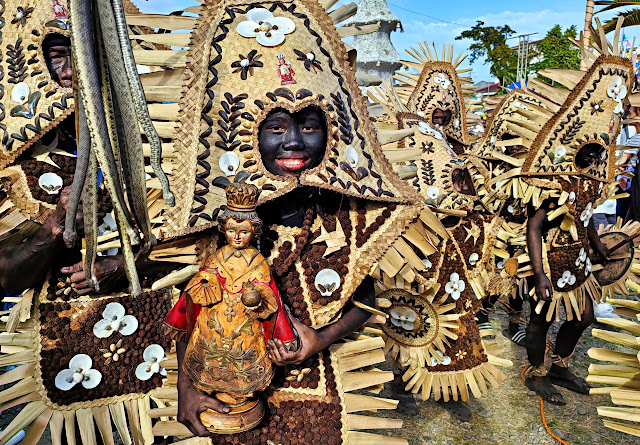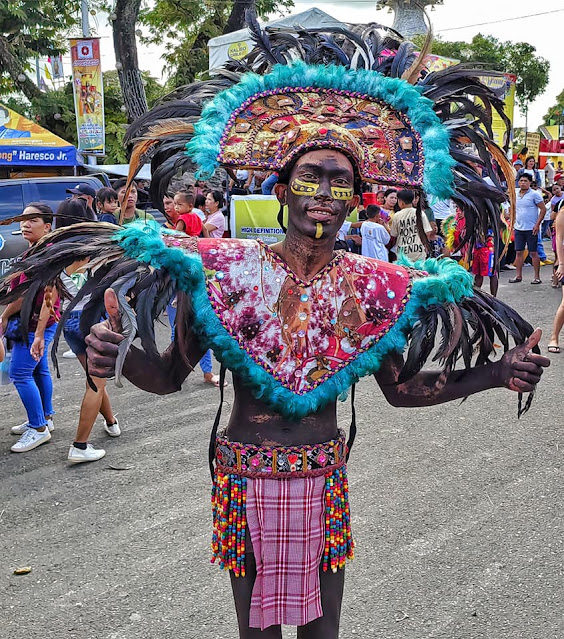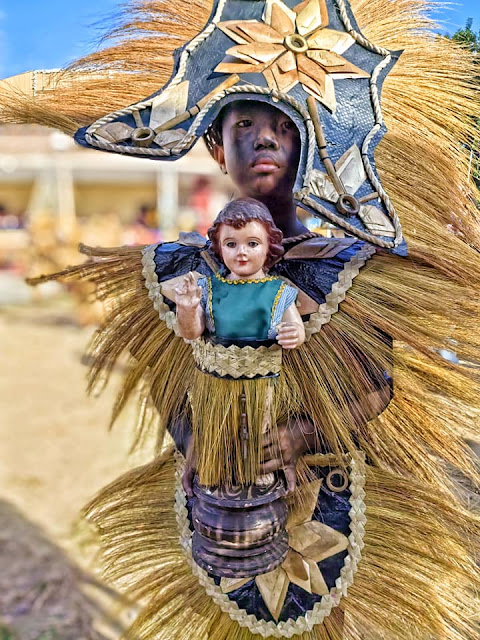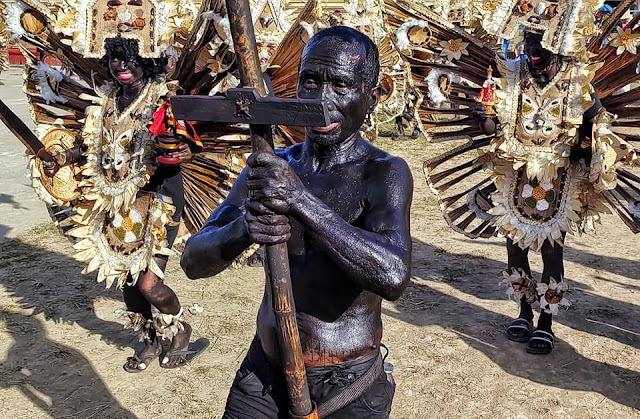It was an
eye-opener to experience the Ati-Atihan for the first time. That was the case
back in 2012. The second time in 2015 was a glorious return, capped off by
drinking a Red Horse beer poured over a still-unused toilet bowl plunger (thank
God). The third one in 2018 was, without a doubt, a charm, celebrating it with
my friends Karla and Erica. When the opportunity to attend the Ati-Atihan for another
time came about, I expected it to be a toss-up between me experiencing a case of the "same-same" or having a great time.
 |
| The Santo Niño is the centerpiece of the Ati-Atihan Festival |
How silly of me to
even doubt the fun-o-meter this revelry would bring, as after witnessing the
Ati-Atihan Festival for the fourth time, I'm pleased that it delivered zero
dullness and instead injected heaps of excitement. I once again found myself boogey-ying
and rocking to the festival’s drumming beat.
 |
| Party and Face color ON |
Besides, as I always
tell my friends, the Ati-Atihan wouldn’t be my favorite Philippine festival for
nothing.
Hala-Bira
Ringed in by yells of “Hala-Bira” followed by a dance move called “sadsad”, which comprise of a one-step backward, two steps forward, step-tap sequence, the Ati-Atihan Festival dates back to the early 1200s, when villagers began commemorating the arrival of ten Malay Datus who were shipwrecked on Panay Island after fleeing a dictatorial kingdom on Borneo.
 |
| You can see countless images of the Santo Niño paraded during the street procession |
The Malay Datus, taken aback by the warm welcome
of the Ati Tribe of Panay, expressed their gratitude by presenting the Ati
chief with a variety of presents, including jewelry, golden salakot, brass
basins, and cloth, which aided their integration into the community. The
Ati-Atihan evolved from a pagan ceremony to a religious festival honoring the
child Jesus Christ (Sto Niño) during the Spanish colonization in the 15th
century. Since then, the Ati-Atihan has been celebrated every third Sunday of January.
A Fusion of Joyful Vibrations
Despite being an almost three-week celebration in January, the revelry reaches fever pitch on the third weekend of the month. We arrived at Kalibo on a red-eye flight Saturday morning, the penultimate day, before the closing ceremony on Sunday.
 |
| The coloring of the face shouldn't be seen as a form of "blackface" that is offensive in the West, since this practice predates it and is meant to give honor to the Ati people. |
Giddy with excitement, we hit the road leading to the town plaza right away. All lanes seem to lead there as a throng of crowds, both spectators and participants, who already have colored faces and are wearing their street dance costumes, fill the streets.
 |
| Vibrant smiles everywhere |
It didn’t take long
as we approached the venue before we began hearing the familiar rhythmic
drumming beats of the Ati-Atihan. The
ground begins to vibrate as the foot-thumping actions expand in swarms, and the
loud noises swiftly rise in decibels. "This party has already started,"
I thought to myself.
 |
| Men, women of all ages and genders participates in the festivity |
Reaching
the main stage, where the many contingents from several high schools in Kalibo
would perform in front of the judges, I quickly selected a spot where I could
take photos and videos.
 |
| Overflowing creativity in every contingent's costumes |
Despite
the scorching glare of the 2:00 pm sun, I gleefully awaited the arrival of
the street dance performers. Not too long after, the first set of Ati-Atihan
tribes started surrounding the plaza, accompanied by a synthesis of basking noises.
 |
| Other than Kalibo, smaller Ati-Atihan festivals are also celebrated in other towns in Aklan |
Referring
to the participating groups as “Ati tribe” to pay homage to the original
settlers of Panay Island, each group comprising young street dance performers
was given not more than ten minutes to display their choreography to the tune
of the signature Ati-Atihan drumming pounding.
 |
| Ati-atihan means ‘making like Atis,’ |
Without
missing a beat from what I could imagine as hundreds of hours of practice sessions, each contingent
came roaring to the plaza grounds, aiming to grab the judges and spectators’
attention by delivering their finest performance to the delight of the crowd.
 |
| Despite the heat, the contingents give their all in making the festival a rousing success |
The
spectacle lasted almost two hours, to the objection of no one. As the
next-to-last event of this year’s Ati-Atihan came to a conclusion, the
performing men and women, young and old, left a trail of bliss along its path.
One could still make out distant cries of "hala bira!" and patches of
rumbling drum battering as the audience slowly disperses and makes their way into the
many stalls of street food.
 |
| Amidst digging into the fun vibe, the Ati Atihan Festival is also a spiritual undertaking |
Feeling
famished from covering the street dance competition, I headed out to one and
had myself some corn on a stick and a refreshing cold drink. Seeing the jubilant faces of the passing
people, I had the impression that the Ati-Atihan party would remain steadfast
all night long until Sunday, the last day.
 |
| During the Ati-Atihan, devotees flock to Kalibo Cathedral to receive a traditional "pahilot" where the priest blesses the devotee's body by rubbing an image of the Sto. Niño. |
By Sunday noon, the curtain had dropped on this year's Ati-Atihan. Overwhelmed
by the sheer exhilaration of witnessing what many refer to as the "mother of
all festivals" in the Philippines, I was ready for a change of scenery.
It's not that I've had enough of the Ati-Atihan; on the contrary, I'm recharging my energies in anticipation of the next time I get my jam on to its wild and rocking rhythm.
 |
| The Ati-Atihan is sometimes compared to Mardi Gras, but I believe it deserves its own distinct identity. |
This
early, I’m already looking forward to doing the sadsad dance steps for the
fifth time. Until then, I'll live my life echoing the Ati-Atihan's cry,
"Hala-bira, hala bira," as I move forward in life with a joyous and
celebratory attitude.






















